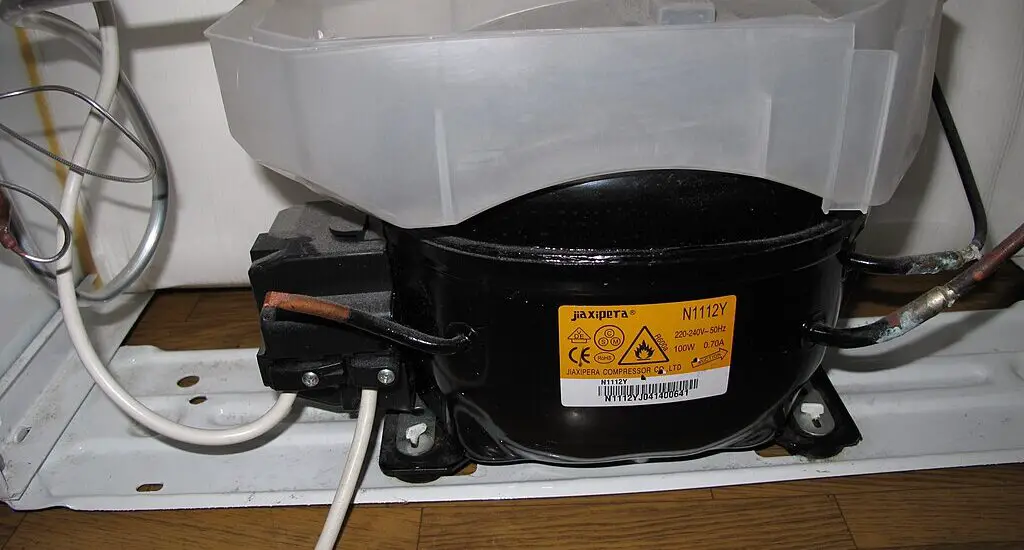This article is a complete guide on the refrigerator compressor discharge line.

Table of Contents
What Is a Refrigerator Compressor Discharge Line?
The refrigerator compressor discharge line is a specialized tube designed to facilitate the flow of compressed refrigerant gas. Usually made of copper or aluminum, this tube carries the gas from the compressor—essentially the heart of your refrigerator’s cooling system—to the condenser coil.
Copper is often preferred because it is a good conductor of heat, which aids in the cooling process. The discharge line is part of a closed-loop system, meaning the refrigerant circulates within sealed tubes and components, which include the compressor, condenser, evaporator, and various valves.
Why Is the Refrigerator Compressor Discharge Line Important?
You might wonder why a simple tube matters so much in the grand scheme of things. The refrigerator compressor discharge line is vital because it is responsible for transporting the high-pressure, high-temperature refrigerant from the compressor to the condenser coil.
In layman’s terms, it is like the artery that takes blood away from the heart and towards the other organs. If this line is compromised—say it leaks or is blocked—the entire refrigeration process gets disturbed.
A malfunctioning discharge line can lead to spoilage of food, energy wastage, and potentially, an expensive repair for the entire cooling system.
How to Locate the Refrigerator Compressor Discharge Line
Identifying the refrigerator compressor discharge line is usually the first step in either replacing or troubleshooting it. You’ll often find this tube at the back of your refrigerator. Here’s a simplified way to locate it:
Unplug your refrigerator from the wall socket for safety reasons.
Move the refrigerator away from the wall so you can access its backside.
Remove the screws from the back panel and carefully take it off.
Once the panel is removed, locate the compressor, which is a large, cylindrical, or boxy component. Connected to it will be the discharge line, typically a narrow tube made of copper or aluminum.
By following these steps, you will successfully locate the compressor discharge line.
Check out these other related articles…
Refrigerator Compressor Auto Cut Off: Your Ultimate Guide
Refrigerator Compressor Burnout: Identification & Solutions
Refrigerator Compressor Buzzing Not Cooling: DIY Fix Guide
Refrigerator Compressor Banging Noise: 3 Quick Fixes
Refrigerator Compressor Bangs When Shutting Off: Easy Fixes
How to Install a Refrigerator Compressor Discharge Line
If you find that your discharge line needs replacement or you’re installing a new one, here’s how to do it step-by-step:
Unplug the Refrigerator: Always unplug the appliance from the electrical outlet for safety.
Expose the Compressor: Remove the back panel as previously described to expose the compressor.
Identify the Discharge Port: On the compressor, you will see several ports. The discharge port is what you’re after; it may even be labeled.
Prep the Line: If using a copper line, make sure to uncoil it carefully to avoid kinks. You may apply the plumber’s tape to the threaded ends for a better fit.
Connect the Line: Attach the line to the compressor by screwing it into the discharge port. Tighten with a wrench but avoid overtightening.
Route to Condenser: The other end of the line will go to the condenser coil. Follow the same connection process.
Test the Connections: Make sure the line is secure at both ends. Give it a gentle pull to confirm it’s tight.
Restore Power: Once everything is secure, replace the back panel and screws, and then plug the refrigerator back into the electrical outlet.
Common Issues and Troubleshooting
If you experience cooling problems or hear strange noises from your fridge, the discharge line could be the culprit. Here’s how to troubleshoot some common issues:
Visual Inspection: The first line of defense is your eyes. Check for obvious signs of wear, such as dents or holes.
Loose Connections: Wobbly or loose connections are a common cause of leaks. Tighten any loose fittings.
Leak Detection: To identify subtle leaks, apply a soapy water solution along the line and look for bubble formation. Bubbles indicate a leak.
Kinks and Bends: A kinked line restricts the flow of the refrigerant. Gently straighten out any kinks, being cautious not to snap the line.
Blockage: Less common but possible is an internal blockage caused by debris or sludge in the line. If suspected, it’s advisable to replace the line.